Xuan Wang
LLM4Cell: A Survey of Large Language and Agentic Models for Single-Cell Biology
Oct 09, 2025Abstract:Large language models (LLMs) and emerging agentic frameworks are beginning to transform single-cell biology by enabling natural-language reasoning, generative annotation, and multimodal data integration. However, progress remains fragmented across data modalities, architectures, and evaluation standards. LLM4Cell presents the first unified survey of 58 foundation and agentic models developed for single-cell research, spanning RNA, ATAC, multi-omic, and spatial modalities. We categorize these methods into five families-foundation, text-bridge, spatial, multimodal, epigenomic, and agentic-and map them to eight key analytical tasks including annotation, trajectory and perturbation modeling, and drug-response prediction. Drawing on over 40 public datasets, we analyze benchmark suitability, data diversity, and ethical or scalability constraints, and evaluate models across 10 domain dimensions covering biological grounding, multi-omics alignment, fairness, privacy, and explainability. By linking datasets, models, and evaluation domains, LLM4Cell provides the first integrated view of language-driven single-cell intelligence and outlines open challenges in interpretability, standardization, and trustworthy model development.
X-MoGen: Unified Motion Generation across Humans and Animals
Aug 07, 2025Abstract:Text-driven motion generation has attracted increasing attention due to its broad applications in virtual reality, animation, and robotics. While existing methods typically model human and animal motion separately, a joint cross-species approach offers key advantages, such as a unified representation and improved generalization. However, morphological differences across species remain a key challenge, often compromising motion plausibility. To address this, we propose \textbf{X-MoGen}, the first unified framework for cross-species text-driven motion generation covering both humans and animals. X-MoGen adopts a two-stage architecture. First, a conditional graph variational autoencoder learns canonical T-pose priors, while an autoencoder encodes motion into a shared latent space regularized by morphological loss. In the second stage, we perform masked motion modeling to generate motion embeddings conditioned on textual descriptions. During training, a morphological consistency module is employed to promote skeletal plausibility across species. To support unified modeling, we construct \textbf{UniMo4D}, a large-scale dataset of 115 species and 119k motion sequences, which integrates human and animal motions under a shared skeletal topology for joint training. Extensive experiments on UniMo4D demonstrate that X-MoGen outperforms state-of-the-art methods on both seen and unseen species.
Diffuman4D: 4D Consistent Human View Synthesis from Sparse-View Videos with Spatio-Temporal Diffusion Models
Jul 17, 2025Abstract:This paper addresses the challenge of high-fidelity view synthesis of humans with sparse-view videos as input. Previous methods solve the issue of insufficient observation by leveraging 4D diffusion models to generate videos at novel viewpoints. However, the generated videos from these models often lack spatio-temporal consistency, thus degrading view synthesis quality. In this paper, we propose a novel sliding iterative denoising process to enhance the spatio-temporal consistency of the 4D diffusion model. Specifically, we define a latent grid in which each latent encodes the image, camera pose, and human pose for a certain viewpoint and timestamp, then alternately denoising the latent grid along spatial and temporal dimensions with a sliding window, and finally decode the videos at target viewpoints from the corresponding denoised latents. Through the iterative sliding, information flows sufficiently across the latent grid, allowing the diffusion model to obtain a large receptive field and thus enhance the 4D consistency of the output, while making the GPU memory consumption affordable. The experiments on the DNA-Rendering and ActorsHQ datasets demonstrate that our method is able to synthesize high-quality and consistent novel-view videos and significantly outperforms the existing approaches. See our project page for interactive demos and video results: https://diffuman4d.github.io/ .
Screen Hijack: Visual Poisoning of VLM Agents in Mobile Environments
Jun 16, 2025Abstract:With the growing integration of vision-language models (VLMs), mobile agents are now widely used for tasks like UI automation and camera-based user assistance. These agents are often fine-tuned on limited user-generated datasets, leaving them vulnerable to covert threats during the training process. In this work we present GHOST, the first clean-label backdoor attack specifically designed for mobile agents built upon VLMs. Our method manipulates only the visual inputs of a portion of the training samples - without altering their corresponding labels or instructions - thereby injecting malicious behaviors into the model. Once fine-tuned with this tampered data, the agent will exhibit attacker-controlled responses when a specific visual trigger is introduced at inference time. The core of our approach lies in aligning the gradients of poisoned samples with those of a chosen target instance, embedding backdoor-relevant features into the poisoned training data. To maintain stealth and enhance robustness, we develop three realistic visual triggers: static visual patches, dynamic motion cues, and subtle low-opacity overlays. We evaluate our method across six real-world Android apps and three VLM architectures adapted for mobile use. Results show that our attack achieves high attack success rates (up to 94.67 percent) while maintaining high clean-task performance (FSR up to 95.85 percent). Additionally, ablation studies shed light on how various design choices affect the efficacy and concealment of the attack. Overall, this work is the first to expose critical security flaws in VLM-based mobile agents, highlighting their susceptibility to clean-label backdoor attacks and the urgent need for effective defense mechanisms in their training pipelines. Code and examples are available at: https://anonymous.4open.science/r/ase-2025-C478.
CARoL: Context-aware Adaptation for Robot Learning
Jun 08, 2025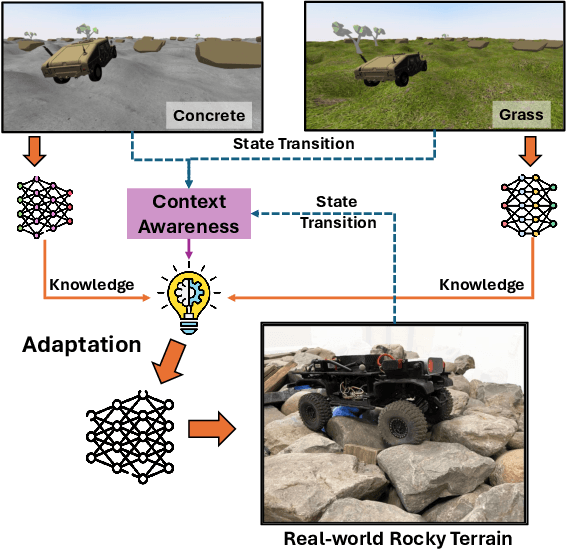
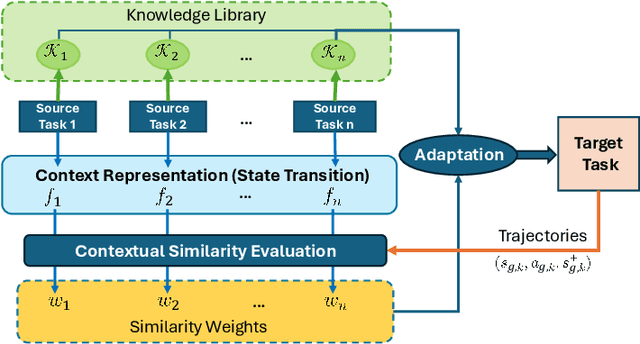
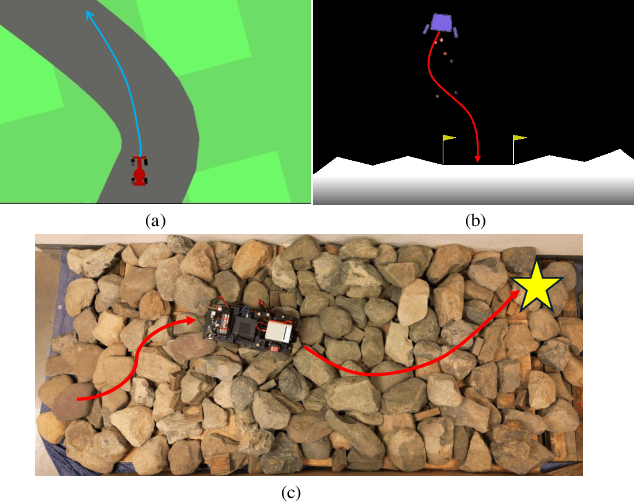
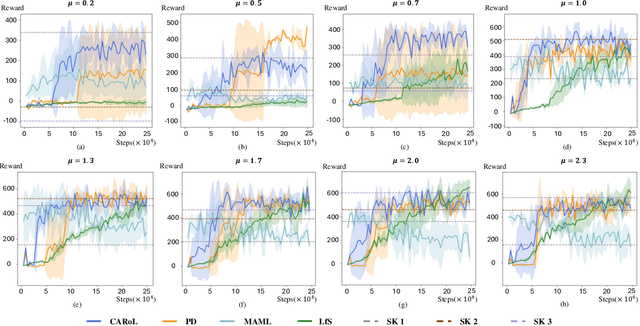
Abstract:Using Reinforcement Learning (RL) to learn new robotic tasks from scratch is often inefficient. Leveraging prior knowledge has the potential to significantly enhance learning efficiency, which, however, raises two critical challenges: how to determine the relevancy of existing knowledge and how to adaptively integrate them into learning a new task. In this paper, we propose Context-aware Adaptation for Robot Learning (CARoL), a novel framework to efficiently learn a similar but distinct new task from prior knowledge. CARoL incorporates context awareness by analyzing state transitions in system dynamics to identify similarities between the new task and prior knowledge. It then utilizes these identified similarities to prioritize and adapt specific knowledge pieces for the new task. Additionally, CARoL has a broad applicability spanning policy-based, value-based, and actor-critic RL algorithms. We validate the efficiency and generalizability of CARoL on both simulated robotic platforms and physical ground vehicles. The simulations include CarRacing and LunarLander environments, where CARoL demonstrates faster convergence and higher rewards when learning policies for new tasks. In real-world experiments, we show that CARoL enables a ground vehicle to quickly and efficiently adapt policies learned in simulation to smoothly traverse real-world off-road terrain.
Active Lubrication of Transluminal Medical Instruments
Jun 08, 2025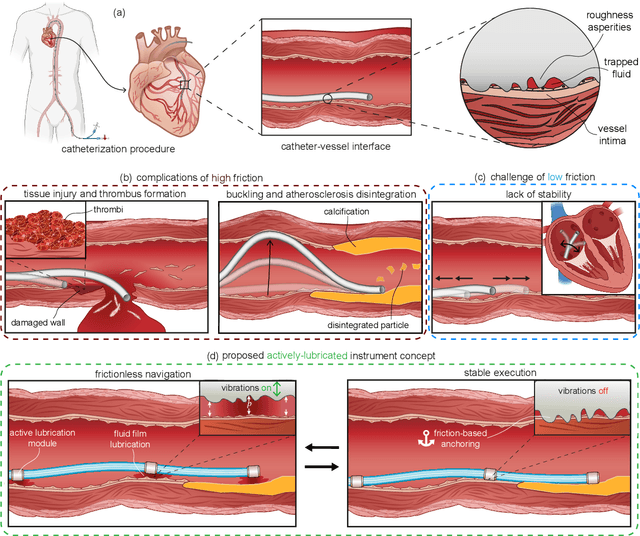
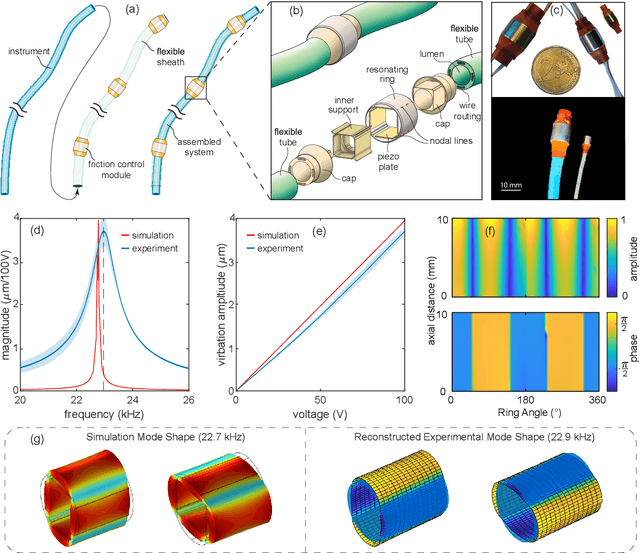
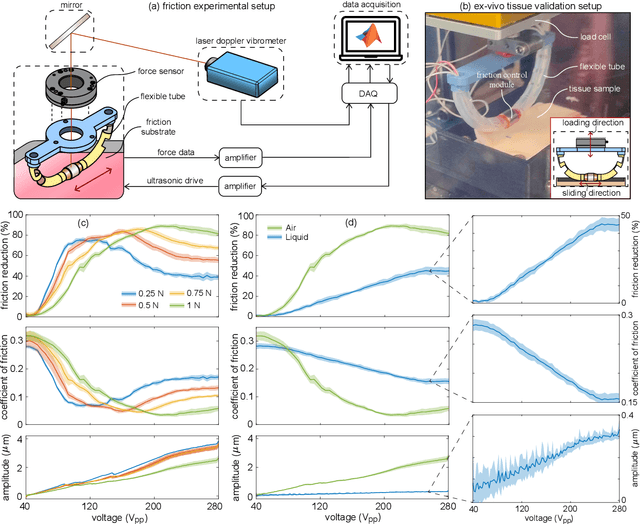
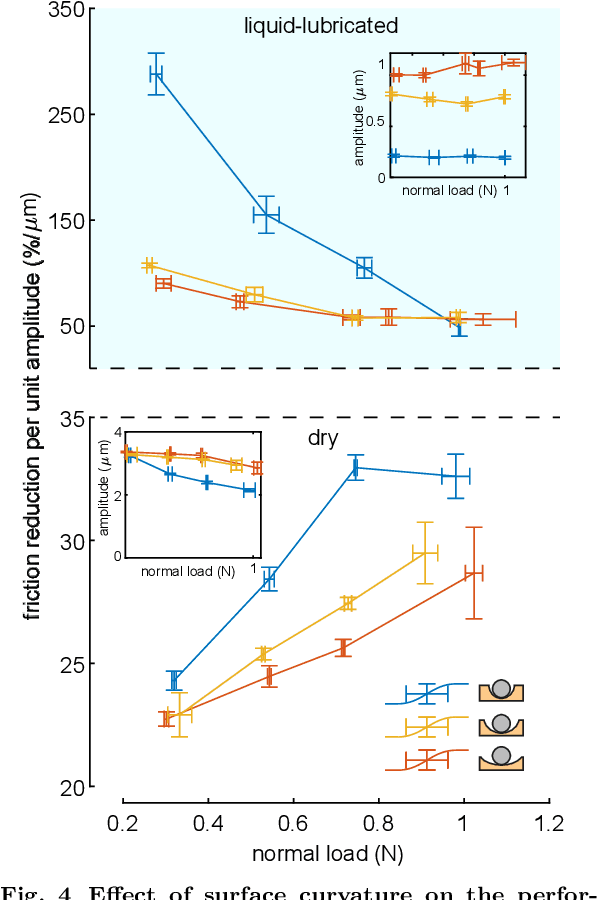
Abstract:Transluminal minimally invasive surgery uses natural orifices and small incisions to access internal anatomical structures, promoting quicker recovery and reduced morbidity. However, navigating instruments--catheters and endoscopes--through anatomical pathways creates frictional interactions with luminal walls, risking complications such as perforation, poor haptic feedback, and instrument buckling. In this paper, we present a new approach to actively lubricate transluminal instruments and dynamically reduce friction with surrounding tissues. This approach employs ultrasonic vibrations, at the instrument surface, to generate a pressurized fluid layer at the contact interface, lubricating the interface and thereby reducing friction. We implemented this approach in a prototype catheter, which we validated under dry and liquid-lubricated conditions, across rigid and soft interfaces, and along varied anatomical curvatures. In a cardiac catheter use case, active lubrication reduced friction by up to 42% on ex-vivo porcine aorta tissue and 82% on rigid substrates, denoting its potential performance on healthy and calcified tissue, respectively. Thermal imaging confirmed that temperature at the tissue-catheter interface remained within safe limits. Additionally, the system effectively prevented buckling during catheter insertion experiment, further showcasing its potential. By minimizing injury risk and enhancing procedural stability, active lubrication can drastically enhance the safety and efficacy of transluminal interventions.
DualTalk: Dual-Speaker Interaction for 3D Talking Head Conversations
May 26, 2025Abstract:In face-to-face conversations, individuals need to switch between speaking and listening roles seamlessly. Existing 3D talking head generation models focus solely on speaking or listening, neglecting the natural dynamics of interactive conversation, which leads to unnatural interactions and awkward transitions. To address this issue, we propose a new task -- multi-round dual-speaker interaction for 3D talking head generation -- which requires models to handle and generate both speaking and listening behaviors in continuous conversation. To solve this task, we introduce DualTalk, a novel unified framework that integrates the dynamic behaviors of speakers and listeners to simulate realistic and coherent dialogue interactions. This framework not only synthesizes lifelike talking heads when speaking but also generates continuous and vivid non-verbal feedback when listening, effectively capturing the interplay between the roles. We also create a new dataset featuring 50 hours of multi-round conversations with over 1,000 characters, where participants continuously switch between speaking and listening roles. Extensive experiments demonstrate that our method significantly enhances the naturalness and expressiveness of 3D talking heads in dual-speaker conversations. We recommend watching the supplementary video: https://ziqiaopeng.github.io/dualtalk.
MDIT-Bench: Evaluating the Dual-Implicit Toxicity in Large Multimodal Models
May 22, 2025Abstract:The widespread use of Large Multimodal Models (LMMs) has raised concerns about model toxicity. However, current research mainly focuses on explicit toxicity, with less attention to some more implicit toxicity regarding prejudice and discrimination. To address this limitation, we introduce a subtler type of toxicity named dual-implicit toxicity and a novel toxicity benchmark termed MDIT-Bench: Multimodal Dual-Implicit Toxicity Benchmark. Specifically, we first create the MDIT-Dataset with dual-implicit toxicity using the proposed Multi-stage Human-in-loop In-context Generation method. Based on this dataset, we construct the MDIT-Bench, a benchmark for evaluating the sensitivity of models to dual-implicit toxicity, with 317,638 questions covering 12 categories, 23 subcategories, and 780 topics. MDIT-Bench includes three difficulty levels, and we propose a metric to measure the toxicity gap exhibited by the model across them. In the experiment, we conducted MDIT-Bench on 13 prominent LMMs, and the results show that these LMMs cannot handle dual-implicit toxicity effectively. The model's performance drops significantly in hard level, revealing that these LMMs still contain a significant amount of hidden but activatable toxicity. Data are available at https://github.com/nuo1nuo/MDIT-Bench.
DEBATE, TRAIN, EVOLVE: Self Evolution of Language Model Reasoning
May 21, 2025Abstract:Large language models (LLMs) have improved significantly in their reasoning through extensive training on massive datasets. However, relying solely on additional data for improvement is becoming increasingly impractical, highlighting the need for models to autonomously enhance their reasoning without external supervision. In this paper, we propose Debate, Train, Evolve (DTE), a novel ground truth-free training framework that uses multi-agent debate traces to evolve a single language model. We also introduce a new prompting strategy Reflect-Critique-Refine, to improve debate quality by explicitly instructing agents to critique and refine their reasoning. Extensive evaluations on five reasoning benchmarks with six open-weight models show that our DTE framework achieve substantial improvements, with an average accuracy gain of 8.92% on the challenging GSM-PLUS dataset. Furthermore, we observe strong cross-domain generalization, with an average accuracy gain of 5.8% on all other benchmarks, suggesting that our method captures general reasoning capabilities.
LanTu: Dynamics-Enhanced Deep Learning for Eddy-Resolving Ocean Forecasting
May 15, 2025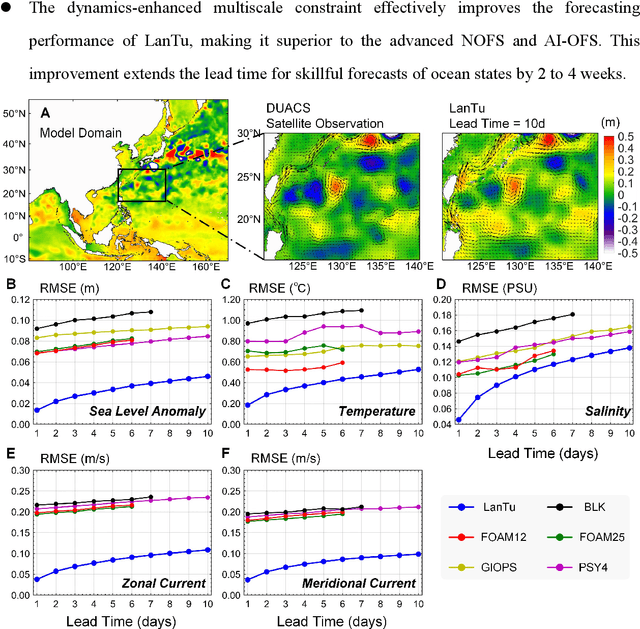
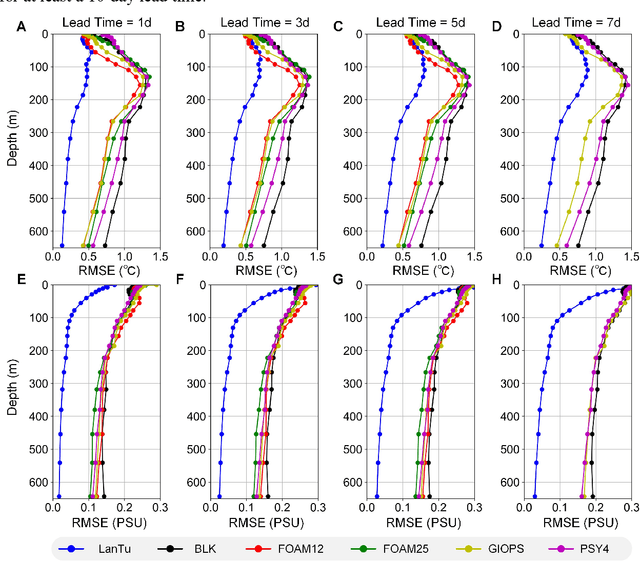
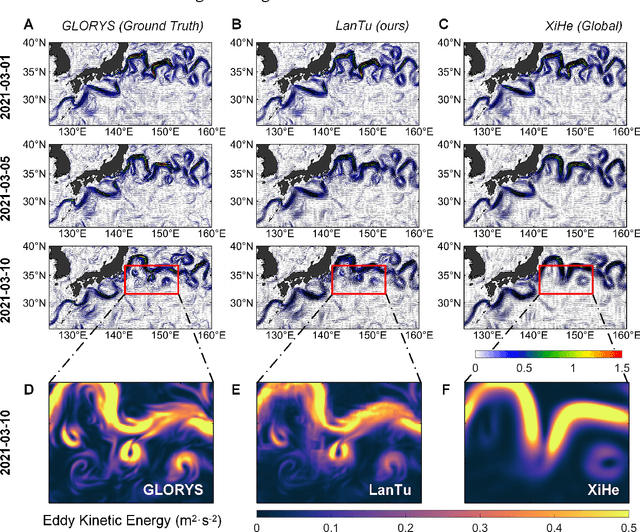
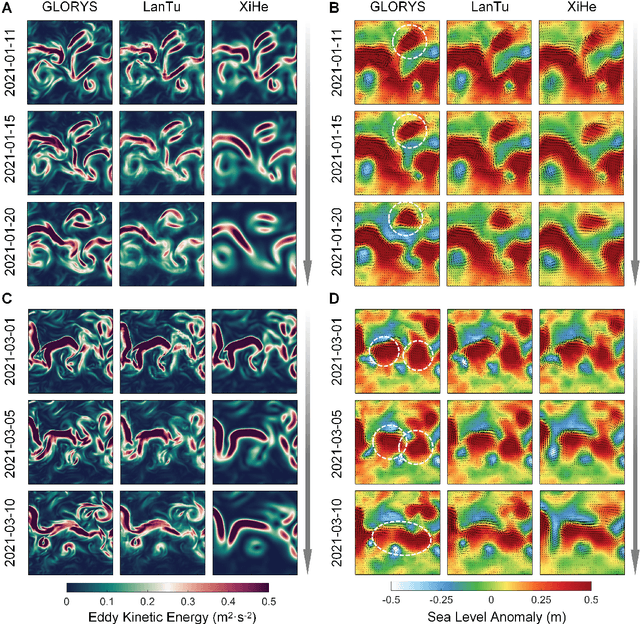
Abstract:Mesoscale eddies dominate the spatiotemporal multiscale variability of the ocean, and their impact on the energy cascade of the global ocean cannot be ignored. Eddy-resolving ocean forecasting is providing more reliable protection for fisheries and navigational safety, but also presents significant scientific challenges and high computational costs for traditional numerical models. Artificial intelligence (AI)-based weather and ocean forecasting systems are becoming powerful tools that balance forecast performance with computational efficiency. However, the complex multiscale features in the ocean dynamical system make AI models still face many challenges in mesoscale eddy forecasting (especially regional modelling). Here, we develop LanTu, a regional eddy-resolving ocean forecasting system based on dynamics-enhanced deep learning. We incorporate cross-scale interactions into LanTu and construct multiscale physical constraint for optimising LanTu guided by knowledge of eddy dynamics in order to improve the forecasting skill of LanTu for mesoscale evolution. The results show that LanTu outperforms the existing advanced operational numerical ocean forecasting system (NOFS) and AI-based ocean forecasting system (AI-OFS) in temperature, salinity, sea level anomaly and current prediction, with a lead time of more than 10 days. Our study highlights that dynamics-enhanced deep learning (LanTu) can be a powerful paradigm for eddy-resolving ocean forecasting.
 Add to Chrome
Add to Chrome Add to Firefox
Add to Firefox Add to Edge
Add to Edge